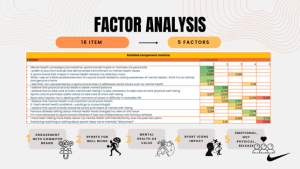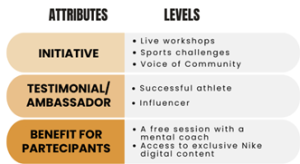
Wellness 2.0 How Nike is redefining the link between mental health and sport
Author: Broggi Lorenzo, Cazzulani Giorgia, Romor Francesco
Date: 29-08-2025
In recent years, mental health has become an increasingly discussed topic. What was once considered taboo is now being talked about more openly.
Collective awareness has grown, as reflected in the rising number of people accessing psychological services. There is a growing recognition that caring for our minds is just as important as taking care of our bodies. Moreover, research highlights a strong correlation between mental and physical health, so much so that physical activity is often prescribed as part of therapeutic treatment by mental health professionals. In response to this holistic shift in wellness perception, even the most iconic brands are becoming active promoters of mental health through dedicated initiatives and campaigns.
A significant example is Nike, long recognized as a symbol of strength, determination, and performance.
Today, through increasingly inclusive and authentic marketing campaigns, Nike addresses themes of fragility, stress, and pressure experienced by athletes, aiming to connect with consumers not just on a commercial level, but on a shared-value level.
Based on this context, we developed our analysis with the aim of exploring whether the perception of mental well-being has changed across generations, the relationship between physical and mental health, the extent to how a sports brand’s communication can influence mental health perceptions, and which consumer segments are most responsive to Nike’s initiatives. We also sought to identify the key factors that could make Nike’s mental health efforts more appealing to different types of consumers.
Our target group included men and women aged 16 to 50, who are either athletes, former athletes, sports enthusiasts, and who are all familiar with the Nike brand.
In the first phase, we conducted eight in-depth interviews: four with young athletes, one with a team coach, one with a psychologist, and two with communication and sports branding experts.

We then distributed an online survey using CAWI methodology via Qualtrics, collecting 214 responses. After removing incomplete questionnaires, rejectors, and straightliners, we obtained 162 valid responses.
The sample consisted of 58% men, mainly aged 21–25. Among them 35% were students, and 30% were employees. The entire sample showed a strong interest in mental health and kept informed via social media posts, videos, and articles on the topic. Participants reported engaging in sports, listening to music, and talking to trusted people as ways to support their mental well-being.
Starting from the questionnaires datas, we conducted bivariate analysis, we addressed our first two research questions:
- How has the perception of mental wellness changed across generations?
Contrary to our expectations, we did not observe a stigma toward mental health among younger generations. However, a notable gender difference emerged: women showed significantly more interest in mental health topics and were more likely to seek psychological support. - What is the bidirectional relationship between physical and mental well-being?
We compared how men and women perceive the role of sports culture in conveying values helpful for managing mental well-being. We discovered that men more strongly recognized this potential, aligning with existing challenges women often face in engaging with sports over their lifetimes, as seen during the desk analysis

From 16 agreement statements in our survey, touching on: mental health, the link between mental and physical wellness and the opportunities for brands to engage with these topics, we extracted five key factors based on communalities, explained variance, and interpretability:
- Engagement with commited brand: Trust and involvement with brands that actively promote mental health, perceived as authentic in their efforts.
- Sport for well being: The belief that sport and physical activity are vital resources for mental well-being.
- Mental health as value: The idea that mental health should be preserved, passed down, and nurtured through professional support.
- Sports icons’ impact: Recognizing the cultural role athletes can play in shaping generational views on mental health.
- Emotional, not physical, release: The belief that a key tool for facing difficult times and caring for one’s mental well-being is open dialogue with friends and family, it also reflects a disillusionment with sport as an effective tool

The identified factors were used as input to conduct the cluster analysis.
After ensuring the statistical significance of the groupings, as indicated in the ANOVA table, and confirming the homogeneity of the clusters, we evaluated the interpretability of the resulting profiles by checking whether they could be clearly described and were useful for subsequent analyses, as well as easily readable from a marketing perspective.
We then identified five clusters to which we assigned the following names:
- Self Storytellers → Members of this cluster are engaged in the dialogue on mental health, consider emotional sharing an essential component of their balance, but do not view sport as a means to well-being.
- Disengaged → They acknowledge the importance of mental health as a social and personal issue but do not feel involved or inspired by brands, sports, or public figures.
- Inspired → They fully recognize the importance of mental health in daily life and find in sport, especially through the authentic stories of athletes, a source of guidance.
- Backers → They have strong trust in sports brands that actively advocate for mental health.
- Athletes → They believe in the value of sport for both physical and mental balance, but do not feel part of a broader discourse around the importance of mental health.
Following some bivariate analyses, most notably the cross-tabulation between clusters and the willingness to participate in Nike’s initiatives focused on mental and physical well-being, we identified three strategic clusters:
- Self Storytellers: Show significantly higher interest in participation than the “Athletes” cluster.
- Inspired: Though less drawn to brand messaging, they are considered strategic due to the fact that they’re highly influenced by athlete role models.
- Backers: Exhibit the highest participation intent compared to all other clusters.

To address our final research question: “What are the key elements that make a Nike initiative on mental and physical well-being attractive to different consumers?” we conducted a conjoint analysis.
Respondents were asked to imagine a new Nike campaign promoting the link between physical and mental wellness. They were presented with 8 cards, each describing different combinations of attributes, each declinated in 3 different levels:
- Type of initiative, with the following levels: Live workshops, sports challenges, voice of community.
- Testimonial, with the following levels: Famous athlete or influencer.
- Benefit, with the following levels: Free session with a mental coach or access to exclusive Nike content.
The ambassador emerged as the attribute with the highest level of importance, a result that remained consistent across age groups and genders after splitting the data file.

We then created three simulation cards based on the following criteria: the ideal initiative, the existing one, and the most easily implementable. The latter, combining a sports challenge, an athlete as testimonial, and access to exclusive Nike content as benefit, proved to be the preferred option across all three simulation methods and was also the top choice for each cluster.

We therefore believe that Nike should guide its choices regarding awareness initiatives on mental and physical well-being based on the preferences of the three previously identified strategic clusters: the Backers, the Inspired, and the Self Storytellers. These groups show a clear preference for an offering that combines a sports challenge, a successful athlete, and access to exclusive Nike content.
Based on these insights, we designed a proposed initiative called “Nike Mind&Motion”: a traveling event across four major Italian cities featuring sports games and challenges.
To enhance the event’s relevance and impact, we envisioned the involvement of role-model athletes from various sports, already sponsored by Nike, who would help promote and participate in the initiative, attracting a larger audience and sharing their personal experiences with sport and mental health.
We suggest offering participants two possible benefits:
- Access to interviews and testimonials from athletes on how they manage their mental well-being, which aligns with the offering identified as the most feasible in our simulation.
- A free session with a mental coach specializing in athlete wellness, an offering that, while less feasible, emerged as the most valuable for each strategic cluster.
To summarize, our analysis started from the belief that there was still work to be done in raising awareness about mental health. Although both qualitative and quantitative analyses revealed a recognized connection between physical and mental well-being, there remains a lack of cultural awareness on this topic in Italy.
This gap could be addressed through the commitment of a sports brand like Nike, which could take on a leading role in promoting initiatives that support these issues. In fact, our cluster analysis revealed the existence of consumer segments open to active involvement, and the conjoint analysis helped us define which types of initiatives would be most successful, positioning Nike as a key player in the field of mental and physical well-being.
While everything we’ve proposed is not intended to be a definitive solution to the stigma that still exists in Italy, we believe it could serve as an excellent starting point to engage people and change their perception of mental health, connecting it with one of the most powerful passions of all: sport.


